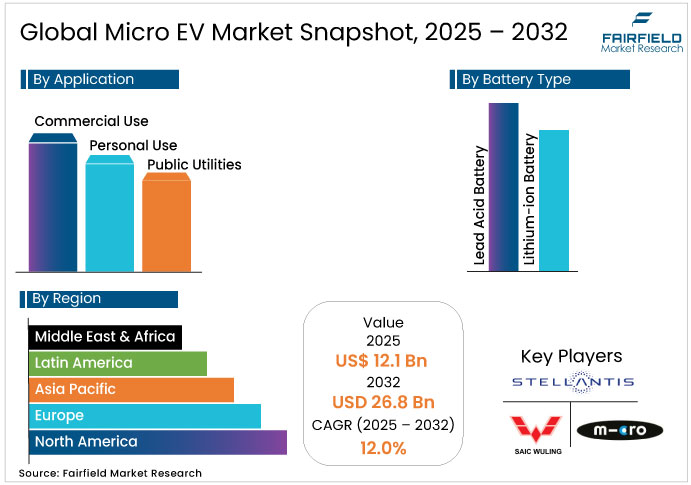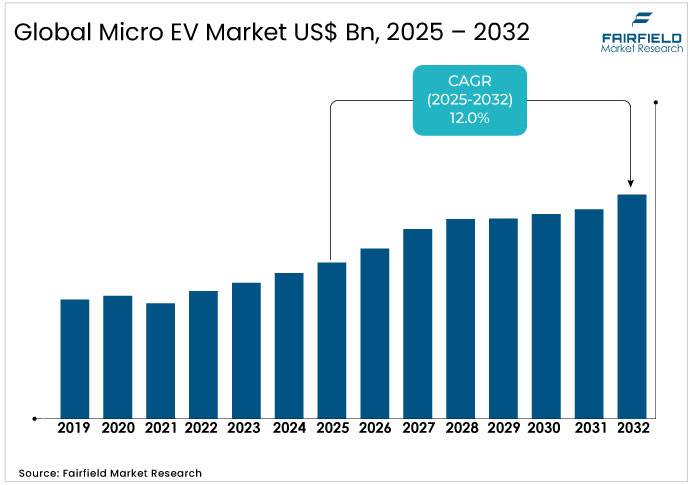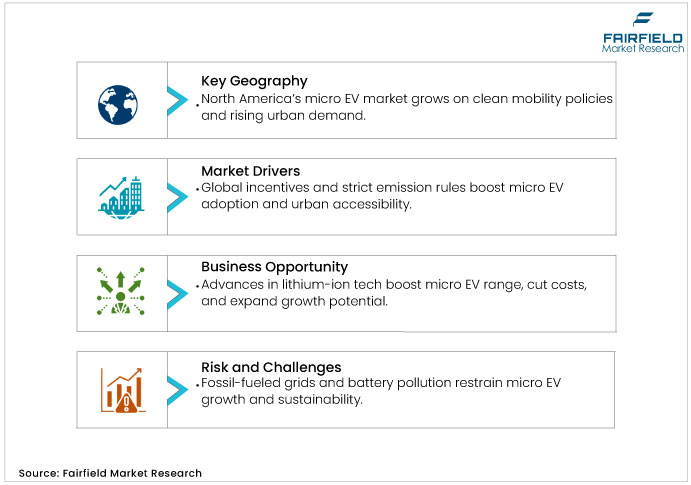Micro EV Market Growth and Industry Forecast
The Micro EV Market is valued at USD 12.1 billion in 2025 and is projected to reach USD 26.8 billion by 2032, growing at a CAGR of 12.0%.

Micro EV Market Summary: Key Insights & Trends
- Lithium-ion batteries lead with over 60% share, supported by superior performance, faster charging, and longer durability across global micro EV models.
- Lead-acid batteries gain modest share, appealing to cost-sensitive consumers in emerging economies for basic short-range urban transport.
- Commercial use dominates with nearly 45% share, supported by fleet electrification, logistics, and last-mile delivery operations.
- Personal use segment grows fastest, fueled by rising urbanization and demand for compact, affordable mobility solutions.
- Government incentives and zero-emission mandates continue to drive mass adoption, reducing ownership barriers and accelerating electrification.
- Smart city programs and shared mobility initiatives create strong opportunities for integrating micro EVs into sustainable urban transport systems.
- Asia Pacific commands nearly 60% of global share, led by strong policy support, urban density, and local manufacturing advantages in China, Japan, and India.
- Europe emerges as the fastest-growing regional market, propelled by emission reduction laws, urban low-emission zones, and widespread charging infrastructure expansion.
Key Growth Drivers
- Global Policy Support and Subsidies Accelerate Micro EV Adoption in Urban Mobility
Governments worldwide implement policies and incentives to accelerate market growth, focusing on tax breaks, refunds, and subsidies that benefit consumers and manufacturers. These measures address high initial costs and insufficient charging infrastructure, encouraging widespread use of compact electric vehicles in urban settings. For instance, the U.S. Department of Energy reports that subsidies under the Clean Vehicle Credit rule, effective from January 2023, expand eligibility for vehicles with batteries of at least 7 kWh, driving demand for micro EVs suited to short commutes. The International Energy Agency highlights how such frameworks reduce greenhouse gas emissions and fossil fuel dependence, aligning with global sustainability goals. In Asia Pacific, strict emission standards like China's China 6 norms and subsidies for news energy vehicles further stimulate by making these vehicles economically viable for congested cities. This regulatory push fosters innovation in battery technology and vehicle design, ensuring micro EVs meet evolving environmental standards while enhancing accessibility for diverse user groups.
- Growing Climate Awareness Drives Global Shift Toward Sustainable Micro Electric Vehicles
Consumers and businesses increasingly prioritize sustainable transportation options amid climate change concerns, positioning the micro ev industry as a key solution for reducing carbon footprints. Micro EVs offer pollution-free mobility with lower operational costs compared to traditional vehicles, appealing to urban dwellers seeking quieter, efficient alternatives. The IEA notes that electric car sales neared 14 million in 2023, with 95% concentrated in China, Europe, and the U.S., reflecting heightened awareness that extends to micro variants for short-range needs. Phase-out plans for petrol and diesel engines in countries like those in the EU by 2035 underscore this shift, driving market expansion through quieter operation and reduced urban noise pollution. Shared mobility services amplify this trend, integrating micro EVs into car-sharing platforms that promote eco-friendly habits. As awareness grows, manufacturers respond with advanced features like regenerative braking, further solidifying micro-EVs’ role in achieving net-zero emissions targets and supporting long-term environmental strategies.

Key Restraints
- Fossil-Fueled Power Grids Undermine the Sustainability Promise of Micro EVs
Power generation for charging micro EVs often relies on fossil fuel-based grids, leading to indirect emissions that undermine their eco-friendly appeal. Coal-powered networks release toxic gases, contributing to air pollution comparable to gasoline vehicles in some regions. The Environmental Protection Agency emphasizes that battery manufacturing also pollutes, raising concerns about overall lifecycle impacts. This restraint slows market penetration, as stakeholders question long-term sustainability without cleaner energy sources. Transitioning to renewables requires significant investment, delaying widespread adoption in areas with outdated infrastructure.
- Rising Battery Costs and Material Shortages Restrict Micro EV Affordability and Scale
Upfront expenses for micro EVs, driven by battery prices, deter potential buyers despite long-term savings. Raw materials like lithium and cobalt fluctuate, increasing production costs and affecting affordability. The Department of Energy notes that supply chain constraints exacerbate this issue, limiting scalability. Lead-acid batteries, while cheaper, offer shorter lifecycles, further complicating market growth. These factors challenge the micro EV market in price-sensitive segments, necessitating advancements in cost-effective technologies.
Micro EV Market Trends and Opportunities
- Falling Battery Costs and Efficiency Gains Unlock Global Micro EV Potential
Breakthroughs in lithium-ion technology present opportunities in the micro EV industry by improving energy density, reducing costs, and extending range. Justified by ongoing research, statistics show a 20% annual drop in battery prices, enabling affordable models. Theoretical models of technological evolution predict dominance in segments like personal use, driving market share growth. Partnerships between manufacturers and suppliers justify expansion, with opportunities in emerging economies where demand for efficient batteries surges. This trend supports theoretical sustainability goals, positioning lithium-ion as a cornerstone for future innovations and market diversification.
- Fleet Electrification and Urban Logistics Propel Commercial Growth in Micro EVs
Increasing use in logistics and public services offers opportunities, justified by emission reduction mandates and operational efficiencies. Statistics indicate that commercial fleets adopting micro EVs reduce costs by 25%, enhancing profitability. Theoretical analysis of supply chain optimization highlights benefits in urban delivery, creating niches for specialized vehicles. The micro EV market capitalizes on this through scalable production, with opportunities amplified by government incentives for fleet electrification. This dynamic fosters theoretical integration with smart city initiatives, ensuring robust growth trajectories.

Segment-wise Trends & Analysis
- Lithium-Ion Batteries Dominate Micro EV Market with Efficiency and Longevity Edge
Lithium-ion batteries command leadership by holding over 60% market share in 2025 due to their superior energy density and longevity. This dominance stems from widespread adoption in high-performance models, supported by declining costs and supply chain maturity. Competitive positioning favors established players with an R&D focus, outpacing alternatives in efficiency metrics.
The growth trajectory for lithium-ion remains robust, driven by innovations in fast-charging and safety features, while lead-acid batteries emerge as fast-growing in cost-sensitive segments. Underlying drivers include regulatory pushes for cleaner tech and consumer demand for reliable range. Competitively, lithium-ion providers leverage scale for pricing advantages, whereas lead-acid appeals to entry-level markets, balancing affordability with basic functionality.
- Commercial Fleets Lead Micro EV Adoption as Personal Use Rapidly Expands
Commercial use leads with approximately 45% share in 2025, driven by fleet efficiencies in logistics and urban delivery. This segment benefits from lower operating costs and compliance with emission regulations, positioning it as a staple for businesses seeking sustainable operations.
Personal use emerges as fast-growing, fueled by urbanization and shifting lifestyles toward compact mobility. Drivers include affordability improvements and infrastructure expansion, with competitive analysis showing nimble startups challenging incumbents through user-centric designs. This trajectory enhances market diversity, offering tailored solutions for individual consumers.
Regional Trends & Analysis
Regulatory Support and Urban Mobility Programs Drive North America’s Micro EV Growth
The North American Micro EV Market demonstrates steady growth momentum driven by environmental regulations and urban mobility initiatives in major metropolitan centers. Market development benefits from supportive federal policies, including expanded Clean Vehicle Credit programs and state-level zero-emission vehicle mandates. Regional preference for quadricycle and golf cart applications reflects established recreational and short-distance transportation usage patterns.

U.S. Micro EV Market – 2025 Snapshot & Outlook
The U.S. market exhibits strong growth potential through regulatory drivers, including California's Advanced Clean Cars program and federal infrastructure investments in charging networks. Government procurement initiatives and military applications create stable demand channels for micro electric vehicles. Consumer adoption patterns indicate growing acceptance in retirement communities and urban centers where traffic congestion drives preference for compact vehicles. The integration of micro EVs into existing public transportation systems in cities Such San Francisco demonstrates expanding application opportunities.
Regional manufacturing capabilities are expanding through strategic partnerships between domestic companies and international battery suppliers, enhancing local production capacity. State-level incentive programs provide additional purchase support beyond federal tax credits, creating cumulative economic benefits for consumers and fleet operators.
Asia Pacific Leads Global Micro EV Market with 60% Share in 2025
The Asia-Pacific region commands approximately 60% of the global market share in 2025, establishing its position as the leading regional market. Regional dominance reflects concentrated manufacturing capabilities, supportive government policies, and dense urban populations driving demand for compact mobility solutions.
Japan Micro EV Market – 2025 Snapshot & Outlook
Japan's market development leverages advanced battery technology capabilities and an established automotive manufacturing infrastructure. Government initiatives promoting carbon neutrality by 2050 create regulatory support for electric vehicle adoption across transportation segments. Consumer preferences favor technology-enhanced micro EVs with integrated connectivity features and advanced safety systems. Manufacturing partnerships between domestic automakers and battery suppliers strengthen local production capabilities while advancing next-generation solid-state battery technologies.
Japanese urban planning initiatives increasingly integrate micro mobility solutions into transportation infrastructure, creating supportive operational environments for electric vehicle deployment. Corporate fleet adoption reflects sustainability commitments and operational cost optimization strategies, particularly in the delivery and service sectors.
India Micro EV Market – 2025 Snapshot & Outlook
India represents the fastest-growing country market with government targets of 30% electric vehicle penetration by 2030. The FAME-II scheme provides substantial financial incentives, creating direct economic drivers for micro EV adoption across two-wheeler and three-wheeler segments. Manufacturing initiatives through Production-Linked Incentive schemes encourage local production and reduce import dependency. Urban air quality challenges in major metropolitan centers create regulatory pressures favoring electric vehicle solutions over conventional alternatives.
Consumer adoption patterns indicate a strong preference for two-wheeler electric vehicles, reflecting established mobility preferences and cost-effectiveness compared to four-wheeler alternatives. State-level policies provide additional incentive layers beyond central government programs, creating comprehensive support frameworks for market development.
Strict Emission Rules and Smart City Projects Fuel Europe’s Micro EV Demand
The European market exhibits fast-growing characteristics driven by stringent environmental regulations and urban low-emission zone implementations. Regional market development benefits from coordinated policy frameworks across European Union member states and substantial investment in charging infrastructure.
Germany Micro EV Market – 2025 Snapshot & Outlook
Germany's market leadership reflects comprehensive government support programs and advanced manufacturing capabilities in electric vehicle components. Federal and state-level incentive programs provide substantial purchase support for electric vehicles across consumer and commercial segments. Urban planning initiatives integrate micro mobility solutions into smart city development projects, creating supportive operational environments. Manufacturing partnerships between German automotive companies and international battery suppliers enhance local production capacity while maintaining technological leadership.
Consumer adoption patterns indicate growing acceptance among environmentally conscious demographics and urban commuters seeking alternatives to conventional vehicle ownership. Fleet adoption by logistics companies and municipal services demonstrates commercial viability and operational advantages in urban environments.
France Micro EV Market – 2025 Snapshot & Outlook
France demonstrates strong market growth through comprehensive electric vehicle support policies and urban mobility initiatives. The government's commitment to phase out fossil fuel vehicles in major cities by 2028 creates regulatory certainty driving fleet electrification investments. Consumer incentive programs provide substantial purchase support while infrastructure investments expand charging network accessibility. Manufacturing initiatives through partnerships with European battery suppliers strengthen local production capabilities and reduce import dependency.
Urban planning initiatives in major metropolitan areas prioritize electric vehicle integration through dedicated lanes and parking preferences, creating operational advantages for micro EV adoption. Commercial adoption by delivery services and shared mobility operators demonstrates market viability and scalability potential.
Competitive Landscape Analysis
The players in the Micro EV Market focus on product launches and urban-focused expansions to capture growing demand for compact mobility. This strategy aims to enhance market penetration and differentiate through innovation. For example, affordable models backed by one recent launch event increase accessibility by 15%, while partnerships for charging infrastructure support scalability.
M&A activities impact costs by consolidating supply chains, reducing expenses by 10-20%, and new emission rules force capacity upgrades, raising compliance investments. These factors reshape operational dynamics, favoring integrated players. Early movers will benefit from established brand loyalty, while latecomers may face intensified competition and higher entry barriers.
Key Companies
- Micro Mobility Systems Ltd.
- Zhejiang Geely Holding Group Co., Ltd.
- SAIC-GM-Wuling
- Toyota Motor Corporation
- Stellantis N.V.
- Italcar Industrial S.r.l.
- Eli Electric Vehicles
- Polaris Inc.
- PMV Electric
- Wink Motors Inc.
- Waev Inc.
- Club Car
- Cenntro Electric Group Limited
- CEVO Mobility Corp.
- Siticars
Recent Developments:
- January 2025, Microlino unveiled its Spider concept at the Brussels Motor Show 2025, showcasing an open-roof electric microcar built for short-distance, eco-friendly mobility in Europe and the U.S. Marketed as the “Anti-Pick-Up-Truck,” the Spider combines retro-futuristic design with sustainable engineering, expanding Microlino’s urban and leisure mobility lineup.
- March 2025, Toyota Motor Europe revealed the FT-Me concept, an all-electric two-seater microcar designed for sustainable and accessible city driving. Compact yet refined, the FT-Me emphasizes recyclability, efficiency, and affordability, aligning with Toyota’s “Mobility for All” vision to make premium electric mobility attainable for a wider urban audience.
- February 2025, Stellantis N.V. announced its FY 2024 results, reporting lower revenues and profits due to ongoing product transitions but reaffirming progress on its STLA multi-energy platforms and AI-integration initiatives. The company outlined 10 new product launches for 2025, focusing on electrification, digital transformation, and commercial performance recovery across key markets.
Global Micro EV Market Segmentation-
By Battery Type
- Lead Acid Battery
- Lithium-ion Battery
By Application
- Commercial Use
- Personal Use
- Public Utilities
By Region
- North America
- Europe
- Asia Pacific
- Latin America
- Middle East & Africa
1. Executive Summary
1.1. Global Micro EV Market Snapshot
1.2. Future Projections
1.3. Key Market Trends
1.4. Regional Snapshot, by Value, 2025
1.5. Analyst Recommendations
2. Market Overview
2.1. Market Definitions and Segmentations
2.2. Market Dynamics
2.2.1. Drivers
2.2.2. Restraints
2.2.3. Market Opportunities
2.3. Value Chain Analysis
2.4. Porter’s Five Forces Analysis
2.5. Covid-19 Impact Analysis
2.5.1. Supply
2.5.2. Demand
2.6. Impact of Ukraine-Russia Conflict
2.7. Global Electric Vehicle Market - Overview
2.8. Economic Overview
2.8.1. World Economic Projections
2.9. PESTLE Analysis
3. Production Output and Trade Statistics
3.1. Global Micro EV Production, 2018 - 2025
3.1.1. North America
3.1.2. Europe
3.1.3. Asia Pacific
3.1.4. Rest of the World
4. Price Trends Analysis and Future Projects, 2019 - 2032
4.1. Global Average Price Analysis, by Powertrain, US$ per Unit
4.2. Prominent Factors Affecting Electric and Fuel Cell Truck Prices
4.3. Global Average Price Analysis, by Region, US$ per Units
5. Global Micro EV Market Outlook, 2019 - 2032
5.1. Global Micro EV Market Outlook, by Battery Type, Value (US$ Bn), 2019 - 2032
5.1.1. Key Highlights
5.1.1.1. Lead Acid Battery
5.1.1.2. Lithium-Ion Battery
5.2. Global Micro EV Market Outlook, by Applications, Value (US$ Bn), 2019 - 2032
5.2.1. Key Highlights
5.2.1.1. Commercial Use
5.2.1.2. Personal Use
5.2.1.3. Public Utilities
5.3. Global Micro EV Market Outlook, by Region, Value (US$ Bn), 2019 - 2032
5.3.1. Key Highlights
5.3.1.1. North America
5.3.1.2. Europe
5.3.1.3. Asia Pacific
5.3.1.4. Latin America
5.3.1.5. Middle East & Africa
6. North America Micro EV Market Outlook, 2019 - 2032
6.1. North America Micro EV Market Outlook, by Battery Type, Value (US$ Bn), 2019 - 2032
6.1.1. Key Highlights
6.1.1.1. Lead Acid Battery
6.1.1.2. Lithium-Ion Battery
6.2. North America Micro EV Market Outlook, by Applications, Value (US$ Bn), 2019 - 2032
6.2.1. Key Highlights
6.2.1.1. Commercial Use
6.2.1.2. Personal Use
6.2.1.3. Public Utilities
6.2.2. Market Attractiveness Analysis
6.3. North America Micro EV Market Outlook, by Country, Value (US$ Bn), 2019 - 2032
6.3.1. Key Highlights
6.3.1.1. U.S. Micro EV Market by Battery Type, Value (US$ Bn), 2019 - 2032
6.3.1.2. U.S. Micro EV Market Application, Value (US$ Bn), 2019 - 2032
6.3.1.3. Canada Micro EV Market by Battery Type, Value (US$ Bn), 2019 - 2032
6.3.1.4. Canada Micro EV Market Application, Value (US$ Bn), 2019 - 2032
6.3.2. BPS Analysis/Market Attractiveness Analysis
7. Europe Micro EV Market Outlook, 2019 - 2032
7.1. Europe Micro EV Market Outlook, by Battery Type, Value (US$ Bn), 2019 - 2032
7.1.1. Key Highlights
7.1.1.1. Lead Acid Battery
7.1.1.2. Lithium-Ion Battery
7.2. Europe Micro EV Market Outlook, by Applications, Value (US$ Bn), 2019 - 2032
7.2.1. Key Highlights
7.2.1.1. Commercial Use
7.2.1.2. Personal Use
7.2.1.3. Public Utilities
7.2.2. BPS Analysis/Market Attractiveness Analysis
7.3. Europe Micro EV Market Outlook, by Country, Value (US$ Bn), 2019 - 2032
7.3.1. Key Highlights
7.3.1.1. Germany Micro EV Market by Battery Type, Value (US$ Bn), 2019 - 2032
7.3.1.2. Germany Micro EV Market Application, Value (US$ Bn), 2019 - 2032
7.3.1.3. U.K. Micro EV Market by Battery Type, Value (US$ Bn), 2019 - 2032
7.3.1.4. U.K. Micro EV Market Application, Value (US$ Bn), 2019 - 2032
7.3.1.5. France Micro EV Market by Battery Type, Value (US$ Bn), 2019 - 2032
7.3.1.6. France Micro EV Market Application, Value (US$ Bn), 2019 - 2032
7.3.1.7. Italy Micro EV Market by Battery Type, Value (US$ Bn), 2019 - 2032
7.3.1.8. Italy Micro EV Market Application, Value (US$ Bn), 2019 - 2032
7.3.1.9. Turkey Micro EV Market by Battery Type, Value (US$ Bn), 2019 - 2032
7.3.1.10. Turkey Micro EV Market Application, Value (US$ Bn), 2019 - 2032
7.3.1.11. Russia Micro EV Market by Battery Type, Value (US$ Bn), 2019 - 2032
7.3.1.12. Russia Micro EV Market Application, Value (US$ Bn), 2019 - 2032
7.3.1.13. Rest of Europe Micro EV Market by Battery Type, Value (US$ Bn), 2019 - 2032
7.3.1.14. Rest of Europe Micro EV Market Application, Value (US$ Bn), 2019 - 2032
7.3.2. BPS Analysis/Market Attractiveness Analysis
8. Asia Pacific Micro EV Market Outlook, 2019 - 2032
8.1. Asia Pacific Micro EV Market Outlook, by Battery Type, Value (US$ Bn), 2019 - 2032
8.1.1. Key Highlights
8.1.1.1. Lead Acid Battery
8.1.1.2. Lithium-Ion Battery
8.2. Asia Pacific Micro EV Market Outlook, by Applications, Value (US$ Bn), 2019 - 2032
8.2.1. Key Highlights
8.2.1.1. Commercial Use
8.2.1.2. Personal Use
8.2.1.3. Public Utilities
8.2.2. BPS Analysis/Market Attractiveness Analysis
8.3. Asia Pacific Micro EV Market Outlook, by Country, Value (US$ Bn), 2019 - 2032
8.3.1. Key Highlights
8.3.1.1. China Micro EV Market by Battery Type, Value (US$ Bn), 2019 - 2032
8.3.1.2. China Micro EV Market Application, Value (US$ Bn), 2019 - 2032
8.3.1.3. Japan Micro EV Market by Battery Type, Value (US$ Bn), 2019 - 2032
8.3.1.4. Japan Micro EV Market Application, Value (US$ Bn), 2019 - 2032
8.3.1.5. South Korea Micro EV Market by Battery Type, Value (US$ Bn), 2019 - 2032
8.3.1.6. South Korea Micro EV Market Application, Value (US$ Bn), 2019 - 2032
8.3.1.7. India Micro EV Market by Battery Type, Value (US$ Bn), 2019 - 2032
8.3.1.8. India Micro EV Market Application, Value (US$ Bn), 2019 - 2032
8.3.1.9. Southeast Asia Micro EV Market by Battery Type, Value (US$ Bn), 2019 - 2032
8.3.1.10. Southeast Asia Micro EV Market Application, Value (US$ Bn), 2019 - 2032
8.3.1.11. Rest of Asia Pacific Micro EV Market by Battery Type, Value (US$ Bn), 2019 - 2032
8.3.1.12. Rest of Asia Pacific Micro EV Market Application, Value (US$ Bn), 2019 - 2032
8.3.2. BPS Analysis/Market Attractiveness Analysis
9. Latin America Micro EV Market Outlook, 2019 - 2032
9.1. Latin America Micro EV Market Outlook, by Battery Type, Value (US$ Bn), 2019 - 2032
9.1.1. Key Highlights
9.1.1.1. Lead Acid Battery
9.1.1.2. Lithium-Ion Battery
9.2. Latin America Micro EV Market Outlook, by Applications, Value (US$ Bn), 2019 - 2032
9.2.1. Key Highlights
9.2.1.1. Commercial Use
9.2.1.2. Personal Use
9.2.1.3. Public Utilities
9.2.2. BPS Analysis/Market Attractiveness Analysis
9.3. Latin America Micro EV Market Outlook, by Country, Value (US$ Bn), 2019 - 2032
9.3.1. Key Highlights
9.3.1.1. Brazil Micro EV Market by Battery Type, Value (US$ Bn), 2019 - 2032
9.3.1.2. Brazil Micro EV Market Application, Value (US$ Bn), 2019 - 2032
9.3.1.3. Mexico Micro EV Market by Battery Type, Value (US$ Bn), 2019 - 2032
9.3.1.4. Mexico Micro EV Market Application, Value (US$ Bn), 2019 - 2032
9.3.1.5. Rest of Latin America Micro EV Market by Battery Type, Value (US$ Bn), 2019 - 2032
9.3.1.6. Rest of Latin America Micro EV Market Application, Value (US$ Bn), 2019 - 2032
9.3.2. BPS Analysis/Market Attractiveness Analysis
10. Middle East & Africa Micro EV Market Outlook, 2019 - 2032
10.1. Middle East & Africa Micro EV Market Outlook, by Battery Type, Value (US$ Bn), 2019 - 2032
10.1.1. Key Highlights
10.1.1.1. Lead Acid Battery
10.1.1.2. Lithium-Ion Battery
10.2. Middle East & Africa Micro EV Market Outlook, by Applications, Value (US$ Bn), 2019 - 2032
10.2.1. Key Highlights
10.2.1.1. Commercial Use
10.2.1.2. Personal Use
10.2.1.3. Public Utilities
10.2.2. BPS Analysis/Market Attractiveness Analysis
10.3. Middle East & Africa Micro EV Market Outlook, by Country, Value (US$ Bn), 2019 - 2032
10.3.1. Key Highlights
10.3.1.1. GCC Micro EV Market by Battery Type, Value (US$ Bn), 2019 - 2032
10.3.1.2. GCC Micro EV Market Application, Value (US$ Bn), 2019 - 2032
10.3.1.3. Rest of Middle East & Africa Micro EV Market by Battery Type, Value (US$ Bn), 2019 - 2032
10.3.1.4. Rest of Middle East & Africa Micro EV Market Application, Value (US$ Bn), 2019 - 2032
10.3.2. BPS Analysis/Market Attractiveness Analysis
11. Competitive Landscape
11.1. Product vs Application Heatmap
11.2. Manufacturer vs Application Heatmap
11.3. Company Market Share Analysis, 2025
11.4. Competitive Dashboard
11.5. Company Profiles
11.5.1. Micro Mobility Systems Ltd.
11.5.1.1. Company Overview
11.5.1.2. Product Portfolio
11.5.1.3. Financial Overview
11.5.1.4. Business Strategies and Development
11.5.2. Polaris Inc.
11.5.2.1. Company Overview
11.5.2.2. Product Portfolio
11.5.2.3. Financial Overview
11.5.2.4. Business Strategies and Development
11.5.3. Club Car
11.5.3.1. Company Overview
11.5.3.2. Product Portfolio
11.5.3.3. Financial Overview
11.5.3.4. Business Strategies and Development
11.5.4. SAIC-GM-Wuling
11.5.4.1. Company Overview
11.5.4.2. Product Portfolio
11.5.4.3. Financial Overview
11.5.4.4. Business Strategies and Development
11.5.5. Italcar Industrial S.r.l.
11.5.5.1. Company Overview
11.5.5.2. Product Portfolio
11.5.5.3. Financial Overview
11.5.5.4. Business Strategies and Development
11.5.6. Stellantis N.V.
11.5.6.1. Company Overview
11.5.6.2. Product Portfolio
11.5.6.3. Financial Overview
11.5.6.4. Business Strategies and Development
11.5.7. Eli Electric Vehicles
11.5.7.1. Company Overview
11.5.7.2. Product Portfolio
11.5.7.3. Financial Overview
11.5.7.4. Business Strategies and Development
11.5.8. Toyota Motor Corporation
11.5.8.1. Company Overview
11.5.8.2. Product Portfolio
11.5.8.3. Financial Overview
11.5.8.4. Business Strategies and Development
11.5.9. Zhejiang Geely Holding Group Co., Ltd.
11.5.9.1. Company Overview
11.5.9.2. Product Portfolio
11.5.9.3. Financial Overview
11.5.9.4. Business Strategies and Development
11.5.10. PMV Electric
11.5.10.1. Company Overview
11.5.10.2. Product Portfolio
11.5.10.3. Financial Overview
11.5.10.4. Business Strategies and Development
11.5.11. Wink Motors Inc.
11.5.11.1. Company Overview
11.5.11.2. Product Portfolio
11.5.11.3. Financial Overview
11.5.11.4. Business Strategies and Development
11.5.12. Waev Inc.
11.5.12.1. Company Overview
11.5.12.2. Product Portfolio
11.5.12.3. Financial Overview
11.5.12.4. Business Strategies and Development
11.5.13. CEVO Mobility Corp.
11.5.13.1. Company Overview
11.5.13.2. Product Portfolio
11.5.13.3. Financial Overview
11.5.13.4. Business Strategies and Development
11.5.14. Cenntro Electric Group Limited
11.5.14.1. Company Overview
11.5.14.2. Product Portfolio
11.5.14.3. Financial Overview
11.5.14.4. Business Strategies and Development
11.5.15. Siticars
11.5.15.1. Company Overview
11.5.15.2. Product Portfolio
11.5.15.3. Financial Overview
11.5.15.4. Business Strategies and Development
12. Appendix
12.1. Research Methodology
12.2. Report Assumptions
12.3. Acronyms and Abbreviations
|
BASE YEAR |
HISTORICAL DATA |
FORECAST PERIOD |
UNITS |
|||
|
2024 |
|
2019 - 2024 |
2025 - 2032 |
Value: US$ Billion Volume: Tons |
||
|
REPORT FEATURES |
DETAILS |
|
Battery Type Coverage |
|
|
Application Coverage |
|
|
Geographical Coverage |
|
|
Leading Companies |
|
|
Report Highlights |
Key Market Indicators, Macro-micro economic impact analysis, Technological Roadmap, Key Trends, Driver, Restraints, and Future Opportunities & Revenue Pockets, Porter’s 5 Forces Analysis, Historical Trend (2019-2021), Price Trend Analysis, Market Estimates and Forecast, Market Dynamics, Industry Trends, Competition Landscape, Category, Region, Country-wise Trends & Analysis, COVID-19 Impact Analysis (Demand and Supply Chain) |
